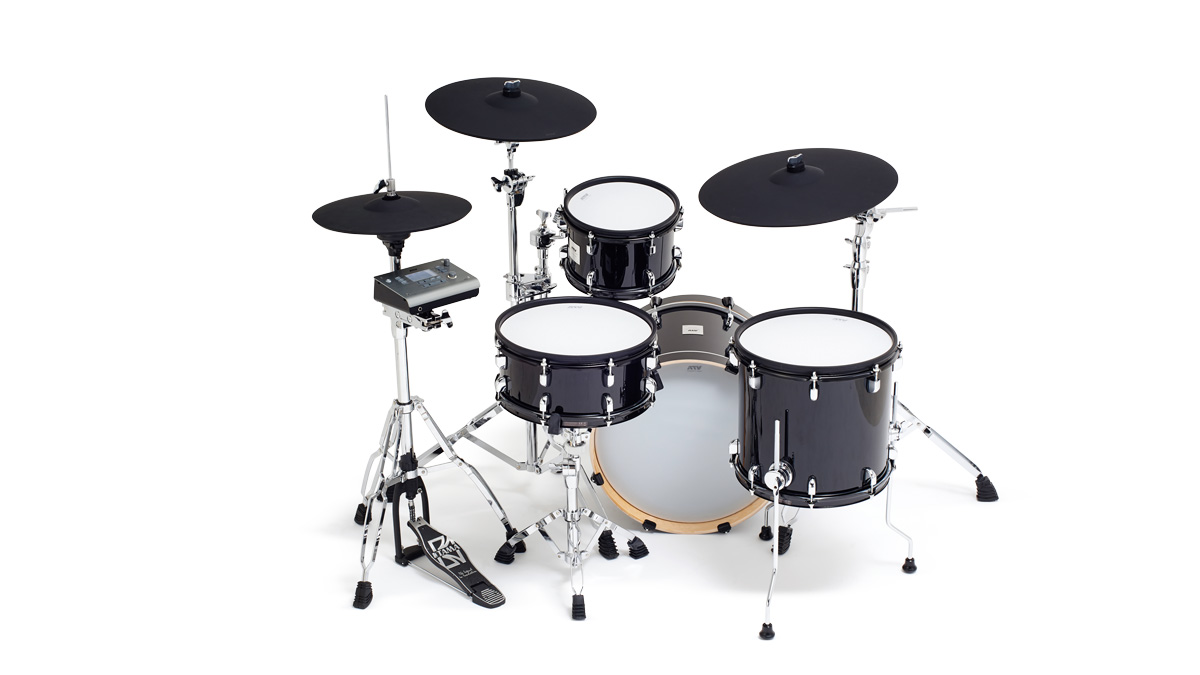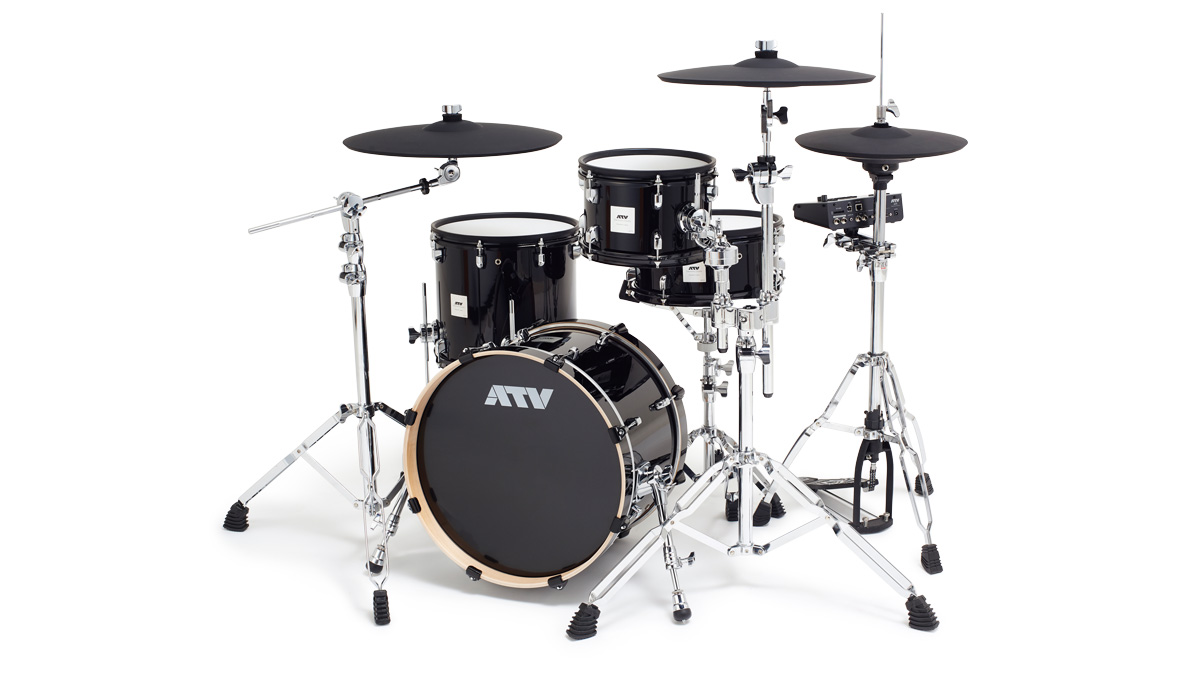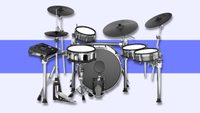MusicRadar Verdict
aDrums definitely push the electronic concept forward, and we can see this kit being used on stages without apology.
Pros
- +
Looks fantastic.
- +
Superb playability.
Cons
- -
Could do with more sounds.
MusicRadar's got your back
Electronic drum sets have come a long way from the unforgiving pads and (by comparison) basic brains of their early days.
No longer is it just about hitting a surface and playing back a sound. The kits of today offer massive functionality, no matter your purpose for buying one - a wide-ranging, versatile soundset and tools for practising on are standard, computer connectivity is practically a given too, offering the ability to record with aftermarket sounds created in the world’s top studios, by top engineers.
We’ve never had it so good. But there is one problem that keeps the e-kit indoors for most: they just can’t better our acoustic kits. ATV was started by late Roland founder and electronic instrument pioneer Ikutaro Kakehashi, and since the company rolled out its aD5 module earlier this year, it has announced aDrums: the e-kit ATV thinks could change acoustic players’ minds.
Build
First things first, it’s important to understand the pedigree we’re dealing with here. ATV was founded on first-hand knowledge of electronic drum development pretty much since its conception. We’re talking the real deal, and with such a visionary founder behind the company it’s important to outline what this kit is, and isn’t, trying to achieve.
According to ATV, the aDrums concept is based on three ‘A’s: authentic, acoustic and artware. That’s a fancy way of saying the focus here is strongly on delivering top-quality acoustic drum (and some percussion) sounds, with a familiar, responsive controller to play them from, presented from a design standpoint that looks beautiful. In short, this e-kit aims to be as close in sound, feel and looks to an acoustic kit as is possible.
In cold, hard spec terms, what does that look like? Well, the kit’s sounds are centred around ATV’s aD5 module that we reviewed earlier this year. But starting with the obvious main event, these are proper drum shells.

Our review configuration is the aDrums Artist Standard: a four-shell kit comprising an 18"x12" bass drum, 10"x61⁄2" rack tom, 13"x12" floor tom and 13"x5" snare. In addition, we get two cymbal pads: an 18" three-zone ride and 16" three-zone crash, plus a 14" hi-hat pad and sensor. It’s expandable, too, with the provision to connect another cymbal and tom pad. A maxed-out Expanded set is also available with these add-ons included.
Each drum shell is a six-ply birch construction, fitted with mesh heads top and bottom, and coated with a black lacquer finish. The snare features three playable zones (head, rim and sidestick) and includes a wooden wedge to aid with the latter, while the toms are dual-zone (head and rim) leaving the bass drum as a single-zone pad.
Hardware is also included in the shape of two cymbal stands (the ADA-TCS doubles as a tom stand, and can also accommodate an extra cymbal holder with its triple-mount clamp), snare stand and mounting brackets.
Hands on
The first thing that hits you about the aDrums set-up is the visuals. Quite frankly, it looks amazing: sleek, neat and classy. The piano-black finish is flawless and looks great combined with the black rubber rims. Put it this way, if Batman plays the drums - and there is no credible evidence to suggest he doesn’t - we reckon that he’d probably plump for something similar to this kit.
However, as with many electronic kits, this rather striking look is diminished somewhat when you attach the wires. To be fair, there’s no practical way around this without integrating the cabling into a closed rack or stand system, thus removing the flexibility of hardware choice.
The pads connect to the aD5 module with a single connector, which splits into a loom, à la Roland, and it’s all very clearly marked. The cymbal pads have two trigger output plugs, one for the edge/bow and another for the bell of each pad. The aD5, however, can only provide all three zones on its ride cymbal input.
If Batman plays the drums - and there is no credible evidence to suggest he doesn’t - we reckon that he’d probably plump for something similar to this kit
Taking a seat at the kit is an interesting experience. Of course, mesh heads are nothing new, and they remain (in this reviewer’s opinion) the closest current alternative to Mylar. As expected, these can be tensioned to adjust for feel, and everything reacts as we’re used to from other brands.
The real win is in the feel of the kit overall. In acoustic terms, this is a bop/jungle-sized kit, but here it doesn’t feel diminutive. The smaller diameter of each drum means that achieving a comfortable placement is quick, with everything within close - but not cramped - range, and while the proportionally deep shells add no acoustic value, they do eliminate the flatness of shallow pads. It feels like you’re sitting at a real kit.
One important feature that electronic kits often fall down on is the hi-hat. The mechanical nature of two cymbals on a clutch is surprisingly difficult to replicate in terms of feel and response. ATV’s hi-hat sensor works by using a contactless, light-sensing design that requires power. While this does mean you need two wall plug sockets to fire up your kit, we think it’s a small concession to make.
The aD-H14 is possibly the best electronic hi-hat we’ve played. At 14", the pad feels right and while you’ll notice the weight difference at first, once you set the clutch to your preferred position on your stand, you’ll forget it’s a pad within minutes. We found it to be fast, dynamic, physically sturdy and very, very real. At no point did we suffer from any mis-hits/positional confusion, and the clutch held it steady without slipping once.
The aD-H14 is possibly the best electronic hi-hat we’ve played
The other cymbals are also impressive, weighty enough to feel substantial, but still capable of moving freely with our strikes. The ride cymbal in particular is a lot of fun, mainly down to the accuracy of the three-position sensor. We moved freely between keeping time on the bow to crashing the edge and accenting the bell, once again without confusing the module and with the natural balance and fluctuation we’d expect between zones.
We’ve reviewed the aD5 module on these pages in the past, but it shouldn’t be overlooked in this context. Combine the module with ATV’s pads and shells and you get a very realistic experience. Every one of the 12 on-board kits has its place, from meaty and modern sounds (DW, Noble & Cooley) to vintage (Gretsch and Slingerland), it’s only the processed-sounding Yamaha 9000 metal kit that drops its guard.
ATV is very clear in its desire to provide fewer, but higher-quality, sounds. The audio is uncompressed, and ATV wants to keep it that way, with no processing. As noted previously, this means that editing is limited, in fact there’s no way of manipulating the raw sounds past basic panning and volume placements. It’s a surprising concept, but for some it will be too much of a closed system.
That said, the included sounds are very special, and additional sounds can be purchased from the ATV Sound store for a few Euros each. Additionally, there is MIDI over USB connectivity if you want to trigger sounds externally from a computer.
Looking for more e-kit options?
Read our best electronic drum sets buyer's guide
Explore our guide to the best electronic drum sets available today, complete with buying advice and our top picks from Roland, Yamaha, Alesis and more.

I'm a freelance member of the MusicRadar team, specialising in drum news, interviews and reviews. I formerly edited Rhythm and Total Guitar here in the UK and have been playing drums for more than 25 years (my arms are very tired). When I'm not working on the site, I can be found on my electronic kit at home, or gigging and depping in function bands and the odd original project.
“A fabulous trip through all eight songs by 24 wonderful artists and remixers... way beyond anything I could have hoped for”: Robert Smith announces new Cure remix album
“He knows what I'm thinking and feeling before I even know it": Billie Eilish suggests that she and brother Finneas can read each other's minds
“A purpose-built solution for bassists seeking unparalleled sound-shaping capabilities”: Darkglass Electronics unveils the Anagram Bass Workstation – a state-of-the-art multi-effects for bass guitar with neural amp model support and a 7” touchscreen











